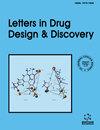Synthesis, Characterization, Antibacterial Evaluation, and Enzyme Inhibition Activity of a Novel Nitrogen-containing Heterocyclic Sulfonamide
IF 1.6
4区 医学
Q4 CHEMISTRY, MEDICINAL
引用次数: 0
Abstract
aims: Synthesis and screening of some novel sulfonamide derivatives with antibacterial and enzyme inhibitory effects. background: Currently, microbial infections are a global threat to human health and there is an urgent need to develop new and effective antimicrobial drugs to treat microbial infections. Carbonic anhydrase II is associated with a variety of diseases in vivo, and the development of carbonic anhydrase II inhibitors has far-reaching implications for the treatment of a wide range of diseases. objective: Synthesis of some novel sulfonamide derivatives containing pyrazole, 1,2,3-triazole and investigation of antimicrobial and enzyme inhibitory activities of the synthesised compounds. method: The compounds with bacteriostatic effect were screened by using the ring of inhibition method and MTT chromogenic method, and the mechanism of bacteriostatic inhibition and description of bacteriostatic effect of the synthesized compounds were investigated with the aid of MOE molecular docking simulation and Gaussian molecular weighting calculations. The in vitro inhibitory effect of the synthesized compounds on COX-2 was studied by phenylmethyl acetate colour development method. result: The results of bacterial inhibition experiments revealed that compounds 11d and 11e had better inhibition effects on pathogenic bacteria, especially on Candida albicans, which was essentially the same as that of the positive control FLUCZ. The compounds 4f, 7b and 11c were found to have the best inhibitory effect by COX-2 in vitro inhibition experiments, especially 11c, which had a better inhibitory effect than the positive control acetazolamide. conclusion: A series of derivatives obtained by introducing pyrazole and 1,2,3-triazole rings into sulfonamides have good bacteriostatic and COX-2 inhibition effects, and have the potential to be developed as novel antimicrobial agents and enzyme inhibitors. other: None other一种新型含氮杂环磺酰胺的合成、表征、抗菌评价和酶抑制活性
目的:合成和筛选一些具有抗菌和酶抑制作用的新型磺酰胺衍生物:合成和筛选一些具有抗菌和酶抑制作用的新型磺酰胺衍生物。 背景:目前,微生物感染是威胁人类健康的全球性问题,迫切需要开发新型有效的抗菌药物来治疗微生物感染。体内碳酸酐酶 II 与多种疾病相关,开发碳酸酐酶 II 抑制剂对治疗多种疾病具有深远的意义:合成一些含有吡唑、1,2,3-三唑的新型磺酰胺衍生物,并研究合成化合物的抗菌活性和酶抑制活性:采用抑菌环法和 MTT 显色法筛选出具有抑菌作用的化合物,并借助 MOE 分子对接模拟和高斯分子权重计算研究了合成化合物的抑菌机理和抑菌效果描述。采用醋酸苯甲酯显色法研究了合成化合物对 COX-2 的体外抑制作用:抑菌实验结果表明,化合物 11d 和 11e 对致病菌有较好的抑制作用,特别是对白色念珠菌的抑制作用与阳性对照 FLUCZ 基本相同。通过 COX-2 体外抑制实验发现,化合物 4f、7b 和 11c 的抑制效果最好,尤其是 11c,其抑制效果优于阳性对照乙酰唑胺:在磺胺类药物中引入吡唑环和 1,2,3-三唑环得到的一系列衍生物具有良好的抑菌和抑制 COX-2 作用,有望开发为新型抗菌剂和酶抑制剂:无其他
本文章由计算机程序翻译,如有差异,请以英文原文为准。
求助全文
约1分钟内获得全文
求助全文
来源期刊
CiteScore
1.80
自引率
10.00%
发文量
245
审稿时长
3 months
期刊介绍:
Aims & Scope
Letters in Drug Design & Discovery publishes letters, mini-reviews, highlights and guest edited thematic issues in all areas of rational drug design and discovery including medicinal chemistry, in-silico drug design, combinatorial chemistry, high-throughput screening, drug targets, and structure-activity relationships. The emphasis is on publishing quality papers very rapidly by taking full advantage of latest Internet technology for both submission and review of manuscripts. The online journal is an essential reading to all pharmaceutical scientists involved in research in drug design and discovery.

 求助内容:
求助内容: 应助结果提醒方式:
应助结果提醒方式:


